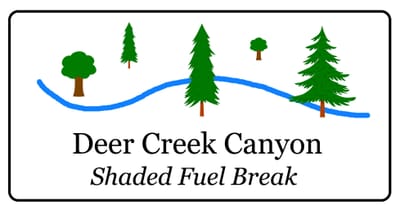Treatment Overview
Treatment guidelines will be similar to those of the Ponderosa West shaded fuel break but may differ depending on the funding source that is ultimately selected.
At this point in time the examples below from Ponderosa West are theoretical only.
Remove live and dead fuels to eliminate fuel ladders, decrease horizontal and vertical continuity of flammable vegetation, decrease flammability, and accelerate decomposition. Healthy small trees and chaparral will be spaced to help prevent fire spread from canopy to canopy.
On tree-dominated sites, average stand density after treatment will be approximately 75-100 basal square feet per acre (see Q&A page for more info). On brush-dominated sites, at least one bush or group of bushes will be retained at most 100 feet apart. On poorly vegetated sites, one bush or group of bushes will be retained at most 30 feet apart.
Conifers greater than 12 inches in diameter at breast height, hardwoods greater than 10 inches diameter at breast height, and brush greater than 8 inches stump diameter will be retained if deemed safe and spacing allows.
Wildlife trees, snags, and/or large woody debris will be retained as important elements of value to wildlife. The SFB will retain at least one per acre averaged across the treatment unit.
Soils, site factors, and timing must be suitable for equipment to avoid excessive compaction, rutting, or damage to soils surface.
Manzanita is a target for removal due to its high burning intensity and ability to send embers a long distance. Large bushes with trunks greater than 8 inches will be retained when spacing allows.
Oaks are not a target species and will be retained for shade and habitat if they are healthy and spacing allows. Multi-trunked oaks will be thinned to promote canopy growth.
McNab cypress, if it exists in the treatment area, will be retained and limbed up to six feet, and young trees will be thinned.
Non-target plants such as coffeeberry, redbud, silk tassel, and toyon will be retained for wildlife food and cover, as spacing permits. These species are not highly flammable.
Riparian overstory trees will be retained as much as possible for shade. Riparian vegetation such as willow, cottonwood, redbud, dogwood, and the like will be retained.
No fuel piling or burning will occur in waterways.
At this point in time the examples below from Ponderosa West are theoretical only.
Remove live and dead fuels to eliminate fuel ladders, decrease horizontal and vertical continuity of flammable vegetation, decrease flammability, and accelerate decomposition. Healthy small trees and chaparral will be spaced to help prevent fire spread from canopy to canopy.
On tree-dominated sites, average stand density after treatment will be approximately 75-100 basal square feet per acre (see Q&A page for more info). On brush-dominated sites, at least one bush or group of bushes will be retained at most 100 feet apart. On poorly vegetated sites, one bush or group of bushes will be retained at most 30 feet apart.
Conifers greater than 12 inches in diameter at breast height, hardwoods greater than 10 inches diameter at breast height, and brush greater than 8 inches stump diameter will be retained if deemed safe and spacing allows.
Wildlife trees, snags, and/or large woody debris will be retained as important elements of value to wildlife. The SFB will retain at least one per acre averaged across the treatment unit.
Soils, site factors, and timing must be suitable for equipment to avoid excessive compaction, rutting, or damage to soils surface.
Manzanita is a target for removal due to its high burning intensity and ability to send embers a long distance. Large bushes with trunks greater than 8 inches will be retained when spacing allows.
Oaks are not a target species and will be retained for shade and habitat if they are healthy and spacing allows. Multi-trunked oaks will be thinned to promote canopy growth.
McNab cypress, if it exists in the treatment area, will be retained and limbed up to six feet, and young trees will be thinned.
Non-target plants such as coffeeberry, redbud, silk tassel, and toyon will be retained for wildlife food and cover, as spacing permits. These species are not highly flammable.
Riparian overstory trees will be retained as much as possible for shade. Riparian vegetation such as willow, cottonwood, redbud, dogwood, and the like will be retained.
No fuel piling or burning will occur in waterways.
